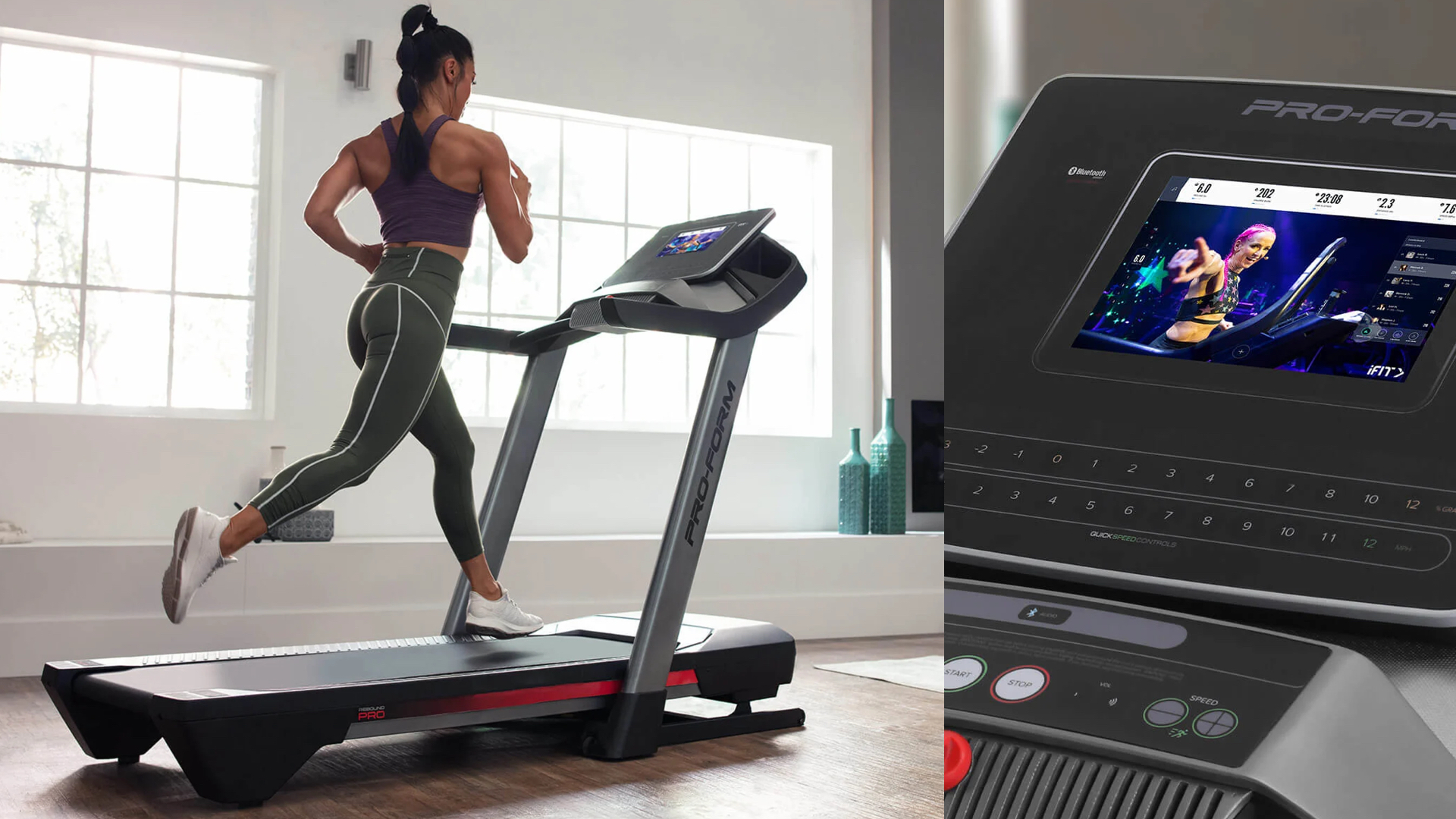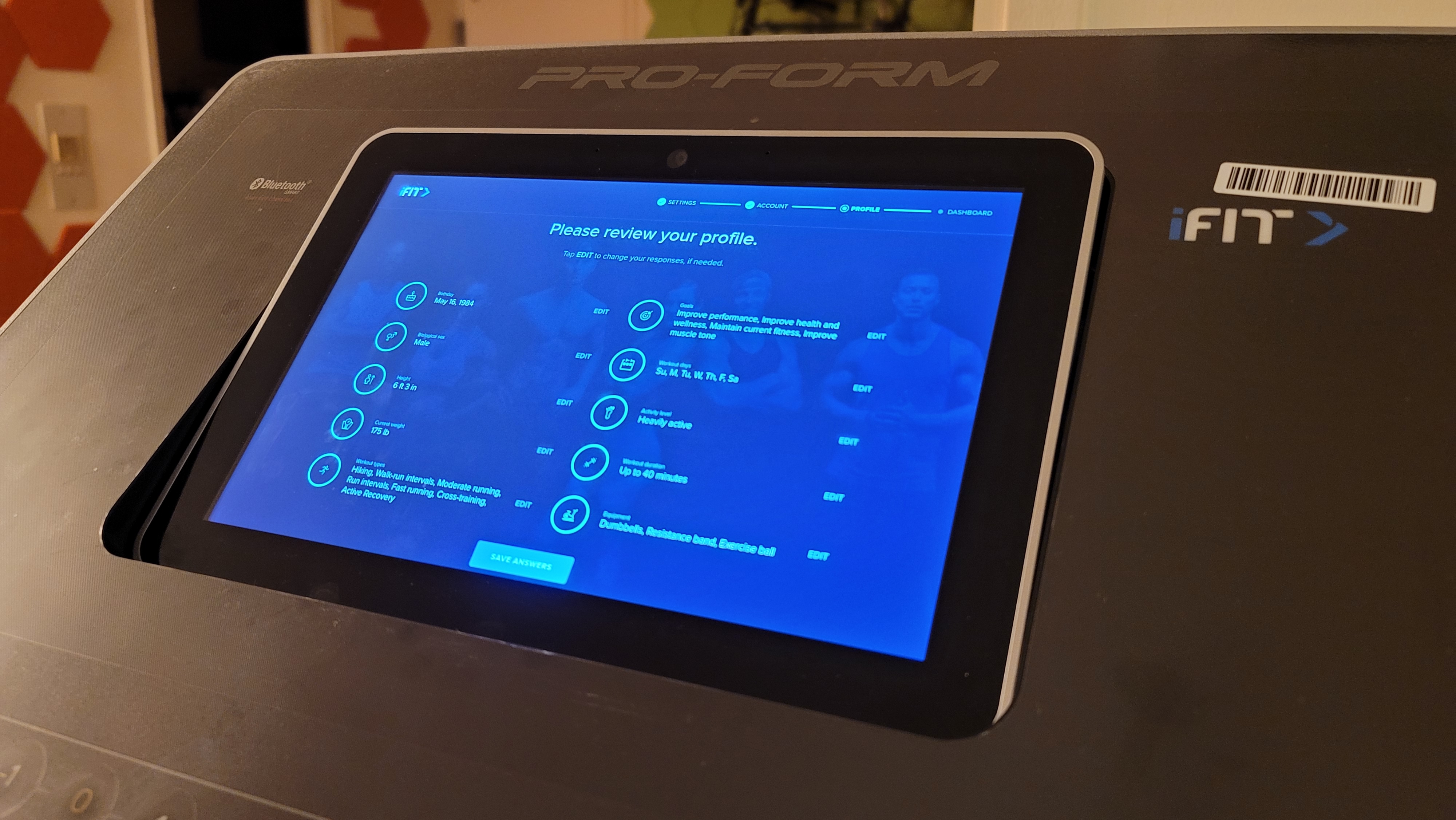ProForm Pro 2000 Review: a flat-out (and uphill) Peloton Tread rival
ProForm Pro 2000 takes HIIT to a whole new stratosphere – and is way cheaper than Peloton's smart treadmill


The ProForm Pro 2000 is cheaper than the Peloton Tread but packs in many comparable features. ProForm’s 10-inch touchscreen is on the smaller side, but iFit’s live studio classes and on-demand workouts still make this one of the best pieces of cardio tech you can buy today. If cardio health is dear to your heart, you’ll more than get your money’s worth.
-
+
Sleek, foldable design
-
+
Cheaper than Peloton
-
+
Free 1-year iFit sub
-
+
Generously sized, shock absorbing belt
-
-
Touchscreen is a bit small
Why you can trust T3
The ProForm Pro 2000 review in a sentence: it's like Peloton Tread for the rest of us.
Proform Pro 2000 is the latest treadmill to enter this year’s international combat-cabin-fever game. There was a period when it was nigh impossible to buy the best treadmills – and the crappiest ones too, in parts of the world – but stock levels are returning to normal. Okay, not 'normal', but you can at least now buy a treadmill without having to remortgage your home to pay a bot-wielding scalper.
There are plenty of futuristic exercise bikes on the market today, but indoor cycling isn’t for everyone, and Peloton wisely released their new treadmill this year to satisfy the rabid running demographic. And they hit their mark, too: In our recent Peloton Tread review, we named it one of the best treadmills on sale today. The bar has been set for tech-centric treadmills, is what I’m saying here.
Quite frankly, however, ProForm should have Peloton shaking in their sneakers. At £1,079/$1,499, the ProForm Pro 2000 is £717/$996 cheaper than the Peloton Tread, which is nothing to sneeze at – especially in the time of Covid.
What’s more, this is a damn good-looking machine, and in my testing, it handily outperformed any other treadmill I’ve ever used at any gym – admittedly, being brand new and only used by me probably helps it there. It has iFit integration, creating a robust ecosystem of cardio workouts that are engaging as they are challenging. Each Pro 2000 treadmill comes with a one-year iFit membership, but you’ll have to shell out £337/$468 annually for the privilege once that trial is up.
So, how does the ProForm Pro 2000 stack up – including against the Peloton Tread? Take your marks, get set and GO (and read the rest of this review)!

ProForm Pro 2000 Review: Price and availability
The ProForm Pro 2000 treadmill is available now directly from ProForm US and ProForm UK for £1,079/$1,499; alternatively, Proform offers a payment plan of £28/$39 per month (for 39 months at 0% APR). Your initial purchase comes with a one-year iFit Family membership (a £336/$468 value) for streaming live and on-demand fitness classes. You don’t need any special equipment to access iFit, however, which can be purchased on its own for £11/$15 per month (individual plan) or £24/$33 per month (family plan).
Get all the latest news, reviews, deals and buying guides on gorgeous tech, home and active products from the T3 experts
By comparison, Peloton Tread packages start at £1,795/$2,495 (for just the treadmill) and go all the way up to £2,205/$3,065 (for the treadmill plus other fitness-focused goodies, such as resistance bands, wireless earbuds, and a heart rate monitor). Peloton charges the same monthly fee as ProForm (£28/$39) for their Tread classes; both services give you access to live leaderboards, allowing you to record and track your workout stats along the way. (You can also pay £9.34/$12.99 per month for the less-robust Peloton Digital membership, which lets you access their classes, but not as many features.)
For either treadmill, these connected features are the main draw, but the machines themselves ain’t so bad, either.
ProForm Pro 2000 Review: Design and build

As a New York City resident, it’s refreshing to hear some buzz about a new fitness brand for once. This town’s been chirping about Peloton nonstop over the past few years after that damn stationary bike took the whole world by storm.
The one-two punch of bleeding-edge fitness tech and on-demand fitness classes proved to be a winning combination, but it’s high time that the premium Peloton price tag got some real competition in the ever-changing world of fitness tech.
Whereas Peloton pulls out all the stops to remind you that theirs is a premium product attached to premium services (complete with branded “white glove”-style delivery and setup), the folks at ProForm have no such pretensions. In fact, my unit was (unfortunately) assembled at the furniture store that delivered it, but the bulky 77.3” x 35.3” x 59.6” frame couldn’t even fit inside my building’s elevator (which is wider than many residential elevators), let alone my apartment doorway.
In the end, my disheartened delivery guys had to take the whole thing apart – piece by piece – in my hallway before reassembling the Pro 2000 in my living room.
At least this proved that the machine can take a little abuse when being shuffled/banged around; after the whole ordeal, my treadmill only had a few scratches to show for it.

Once set up and in place, the foldable design is elegantly simple. No treadmill is exactly chic but the Pro 2000 is hardly an eyesore.
The 10-inch touchscreen can tilt up and down and looks good enough, though it doesn’t hold a candle to Peleton’s gorgeous 23.8-inch offering. Having a smaller screen size does negatively impact the whole personal training experience, but you get what you pay for.
Note: the screen is also equipped with a webcam of some kind, but at the moment, it’s not utilised by the iFit software. Upgradeability is never a bad thing, although I'm sure many users won't want to be watched working out anyway!

Setting up iFit for the first time is simple enough once you’ve powered on the machine. After inputting the included membership code, my profile was ready to go in less than 10 minutes. Make sure you’ve got a good Wi-Fi connection for those live classes, though.

The control panel is intuitive and easy to navigate. Beneath the touchscreen is the “quick controls” section to instantly adjust your speed or incline on the fly. Beneath that, you’ll find the Bluetooth pairing button and additional controls for speed, incline/decline, the built-in fan, speaker volume, and starting/stopping of the treadmill belt.
There’s also a safety key that clips to your clothing; if the key gets pulled out, your workout pauses automatically. (This might seem like a trivial feature, but if you bump the speed all the way up to 12mph, you might change your mind. Safety first: don’t try running at speeds your body isn’t used to.)
All in all, the ProForm Pro 2000 treadmill is a slick contraption that’s easy to use, easy to navigate, and easy to store – once you get it through the right doorway, that is.

ProForm Pro 2000 Review: Performance
To provide a little context for this review, here’s the deal: I’m a 37-year-old man with a dodgy knee, so running, especially on harder surfaces, used to be a tremendous challenge. That being said, I underwent a 70-pound weight-loss transformation in 2011, and I got there by doing HIIT running workouts in Central Park at night.
I currently weigh 180 pounds, and I’m 6-foot-3-inches tall, so now that I’ve lost the weight, my lanky body has evolved into a runner’s frame, and I genuinely enjoy the sport since shin splints are finally out of the equation.
At 60” x 20”, the ProForm running belt is generously proportioned – just a hair longer than Peloton. If your legs happen to be as orangutan-y as mine, every extra inch of tread space counts. The ProForm Pro 2000 can support users up to 300 pounds – which happens to be identical to Peloton Tread.

When it comes to incline and speed, however, Peloton has the edge: whereas the Pro 2000 has a max incline of 12% and a max speed of 12 mph, Peloton offers a 12.5% incline and 12.5mph max speed. I’m a pretty active fella, and I can only last 30 seconds at 12% and 12mph; you’ll definitely get your money’s worth with either model, and your workouts don’t have to be gentle.
While it’s easy to dive into live or on-demand classes via iFit (more on that below), you can jump into a manual workout just by pressing the start button. The touch-sensitive controls worked seamlessly, and the mechanisms that adjust the incline/decline work smoothly as butter when engaged. (That built-in fan is refreshing, too.)
But let’s talk about that running surface. Designed with what ProForm calls ReBound Pro cushioning, the treadmill deck was absolutely built for comfort and speed. Indeed, this was the most comfortable treadmill my knees have ever seen, and I’ve visited some pretty premium fitness centres over the years. My joints and spine enjoyed excellent bounce with every stride, and the machine itself doesn’t budge when in use – even at top speed. (I did put some rubber truck mats between the treadmill and floor, though, for the sake of my neighbours below.)
I live on the fourth floor of my apartment building, so I was a little concerned about accidentally creating a “Turn Down for What” situation when the ProForm Pro 2000 was first delivered. As you can see in the video below, however, even at max speed and max incline, this treadmill is stable as hell.
Editor’s note: When evolution was doling out ADHD, it stole mine from a nearby mountain goat. Don’t max out your speed and incline settings unless you’re absolutely positive your legs are up for it; treadmill wipeouts might look hilarious on YouTube, but they're not as funny IRL.
Long-story-long, the ProForm Pro 2000 is more than capable of challenging both casual and serious athletes alike, and the overall running experience feels fantastically springy. Now, if only I had some friends to go jogging with...
ProForm Pro 2000 Review: iFit studio classes and live workouts
As mentioned above, the best thing going for the ProForm Pro 2000 is the baked-in iFit integration, which makes any running routine far more dynamic (and flat-out fun). Your iFit subscription is the virtual gateway to dozens of world-class personal trainers, accessible right from your living room. Or garage.
iFit is fully loaded with fun fitness features, and here are a few of my favourites:
Livecast - Lets you join live studio classes right from the treadmill console. These classes change all the time, and each instructor brings their own personality to the mix – iFit has a terrific team of personal trainers, from everything I’ve seen so far.
A few minutes before the start of each class, a barcode appears on the screen for you to scan, allowing you to text your trainer just before the workout begins; they respond in real-time once things get moving. This is definitely a cool layer of interactivity, and I sure appreciated the extra motivation as I huffed away.

Leaderboards - This became an unexpectedly huge perk for me since it brought out some of my (mildly) competitive nature. Interacting with a miniature community for each class is pretty cool, and the more you take, the more usernames you start to recognize. Not for nothing, but these interactions take the edge off my COVID-cabin fever, at least temporarily.
Globetrek - Follow various trainers on location in exotic landscapes from around the globe; your treadmill magically automatically adjusts your speed and incline for the trek. (For example, on March 22nd at 8 pm (EST), a team of badass mountaineers – and one presumably chilly cameraman, I presume – will be leading a sunrise hike on Mt. Everest. You better believe I’ll be there too, wearing flip-flops and absolutely nothing else. Because why the hell not.)
Google Maps - You can access Street View (via Google Maps) and create custom running routes however you like. For example, you could map out a customized run along Miami Beach; Google’s Street View refreshes every few seconds as you run to update your location. This feature was pretty laggy in practice, but I dig the concept. (Hmm, maybe that webcam will facilitate real-time workout with other members, as iFit’s partnerships evolve.)
Much to my unexpected delight, I discovered during testing that an old friend of mine is currently an iFit trainer, leading three cardio classes nearly every day from iFit’s Utah studio. In no time at all, I was signed up for one of his HIIT classes, and getting a shoutout from Jesse from Utah – through my treadmill speakers – was pretty cool. Hot damn, living in the future is awesome.
ProForm Pro 2000 review: The verdict
If you’re on the prowl for a cloud-connected treadmill that won’t break the bank, look no further than the ProForm Pro 2000. For nearly $1K less than the excellent Peloton Tread, you get comparable features in a comparably attractive package. Granted, the treadmill itself is only half the investment, but even without all that useful iFit integration, the machine stands alone as a solid piece of gym equipment, sans software.
Once you add iFit to the mix, however, things really start to get interesting. Yes, you'll need a monthly subscription to access the Pro 2000’s best features. However, if you’re already spending £11/$15 to £36/$50 on a gym membership anyway, you could easily swap one expense for the other. The pricing seems more than reasonable for great cardio workouts in the privacy, safety, and comfort of your own home.
Bottom line? I love this treadmill.
ProForm Pro 2000 review: Also consider
Haven't got quite enough money to get the ProForm Pro 2000? Consider the Viavito LunaRun Fold Flat Treadmill (if you're in the UK). This is a fold-flat treadmill with a power incline and a slightly wider and longer deck than the standard small running machines. It’s great for runners with limited storage space and ideal for those who are not comfortable setting up a treadmill on their own.
Another Peloton Tread-alternative is the Echelon Stride. This is a great option for runners on the market for a straightforward, easy-to-use treadmill that won’t monopolise too much space. While the Echelon Stride is a more basic model, it has everything you need to get in a solid workout.

As a freelance journalist, TJ has over a decade of multi-medium storytelling under his belt. Leveraging a quarter century of collective coddiwompling amid the ever-evolving landscape of wireless gadgetry, his unique editorial background allows him to explore a variety of tech-centric subsectors on this fascinating planet. When he's not field testing new gear in the Catskills, Adirondacks, or an actual field, he can be found sipping Negronis in his living room and crafting Dr. Seussian poetry inside a tattered moleskin.
